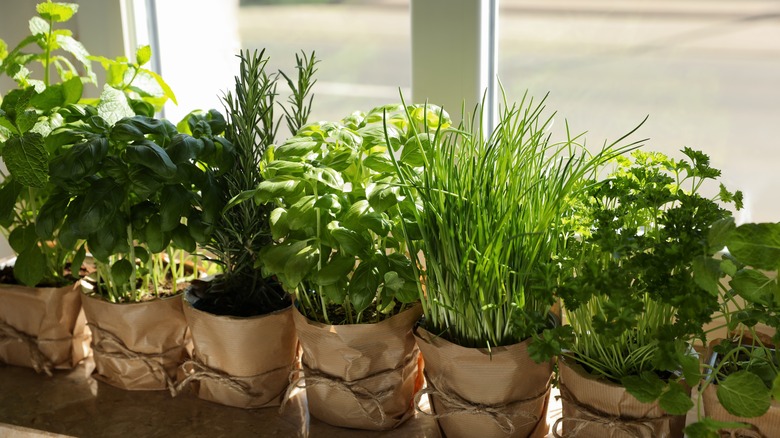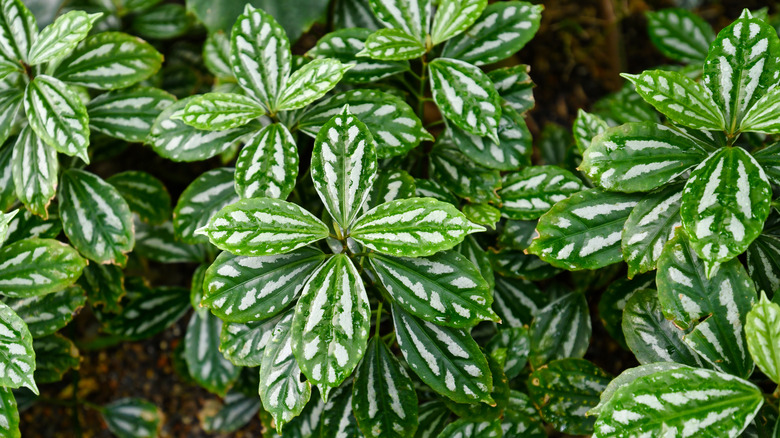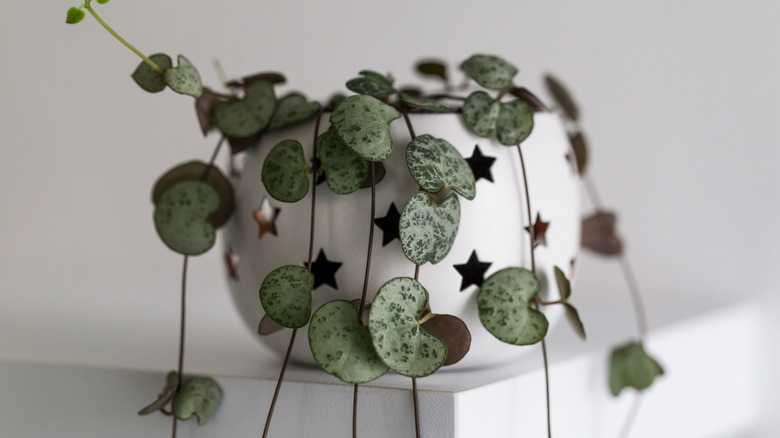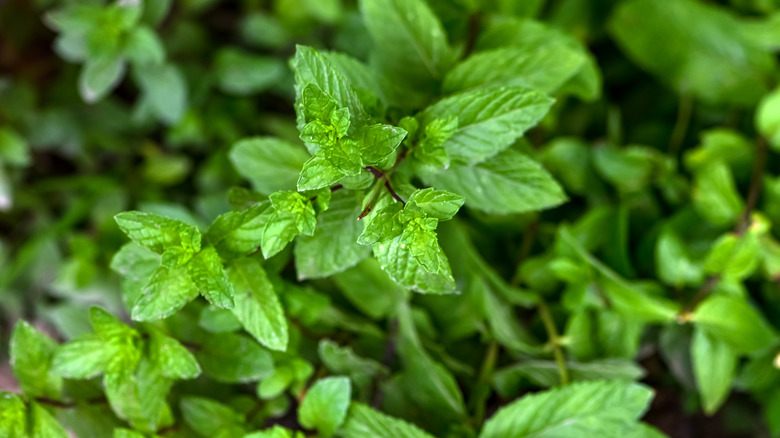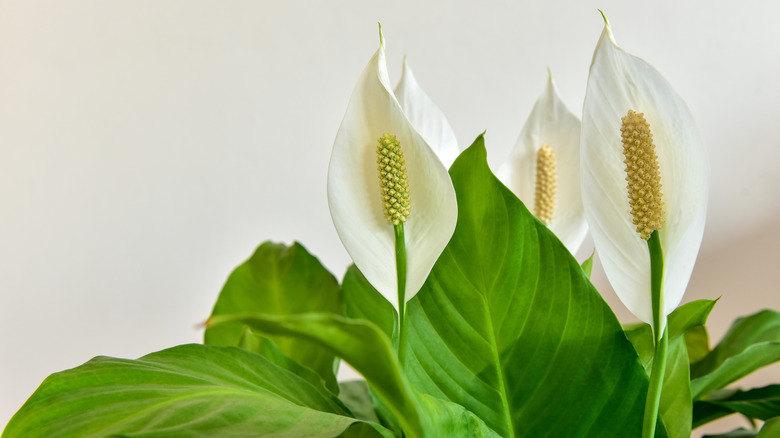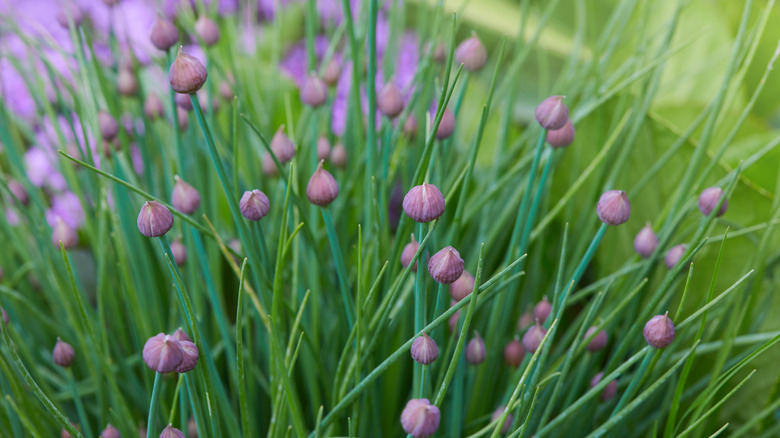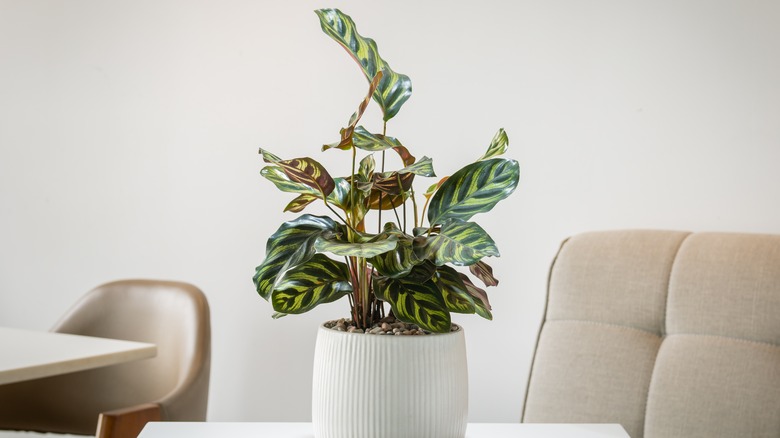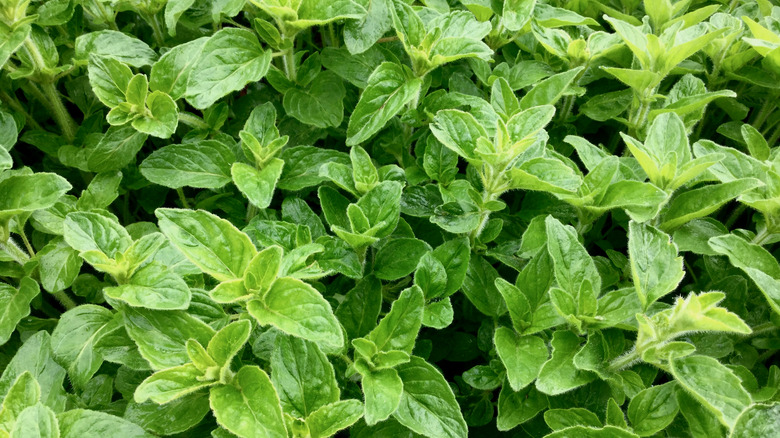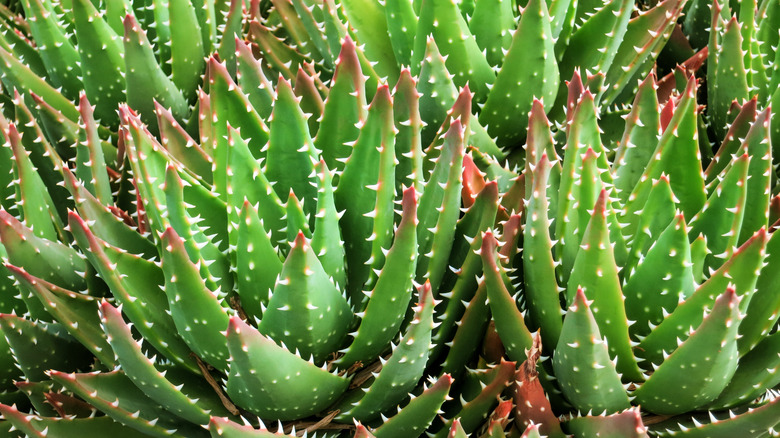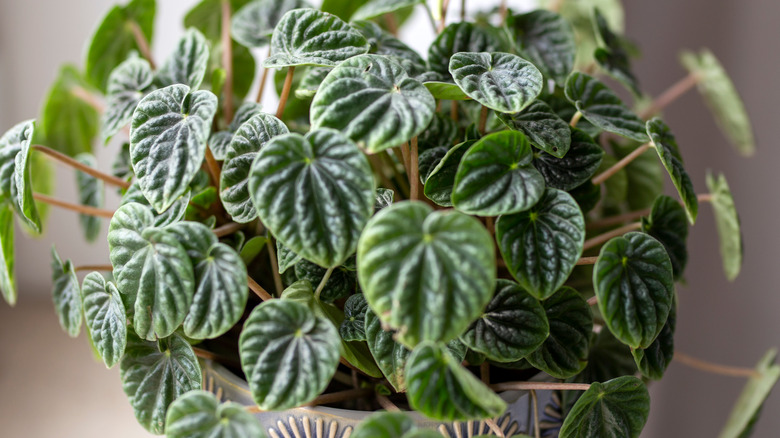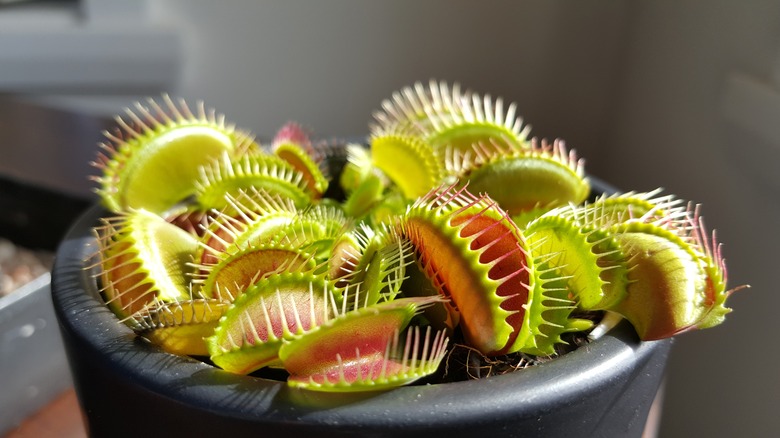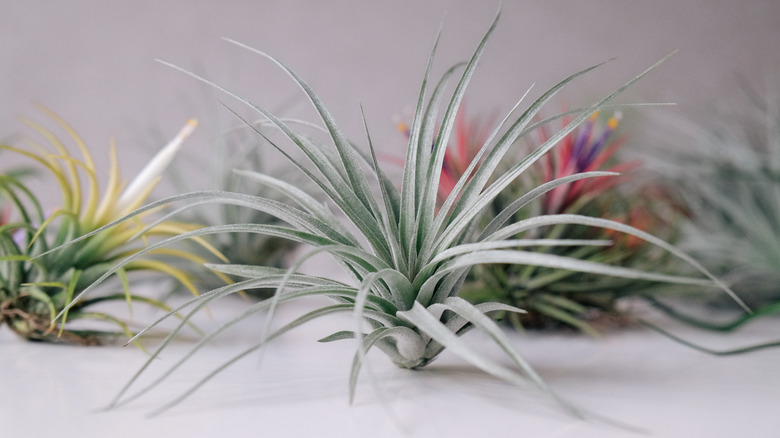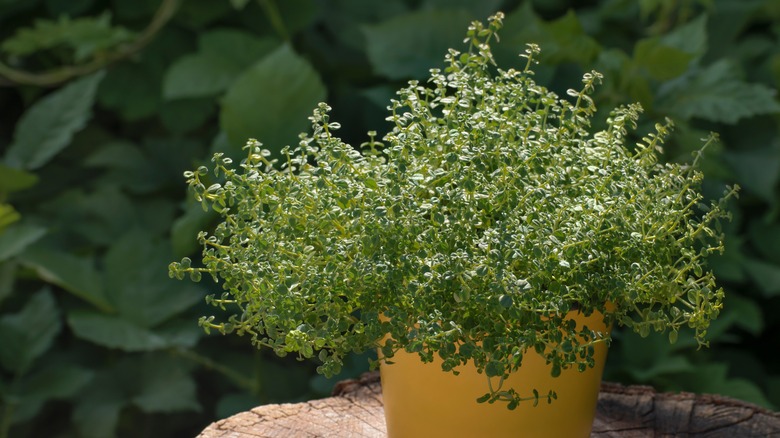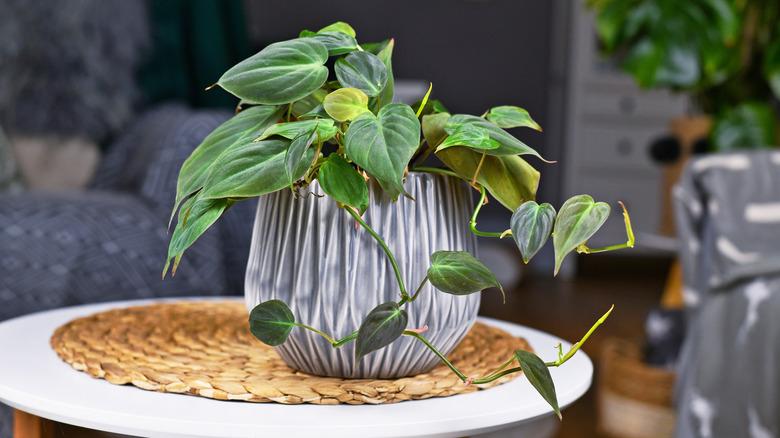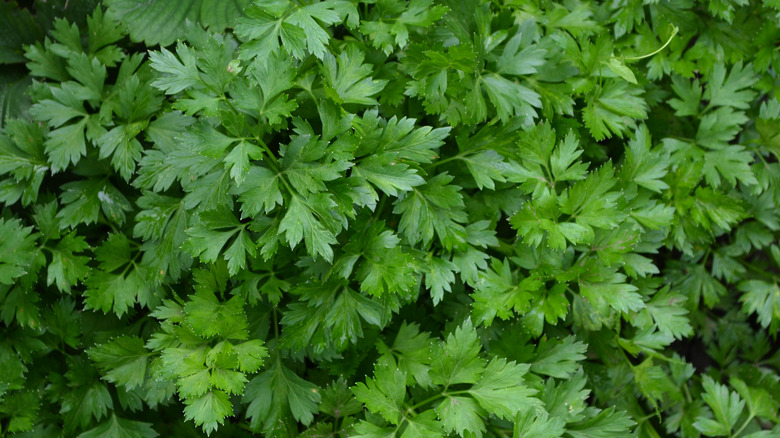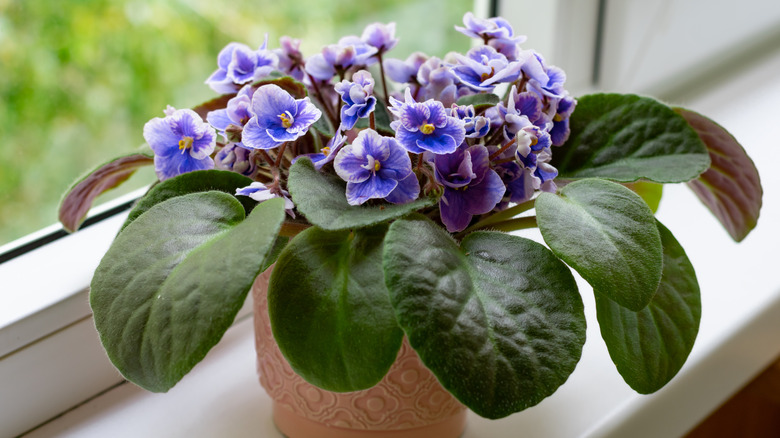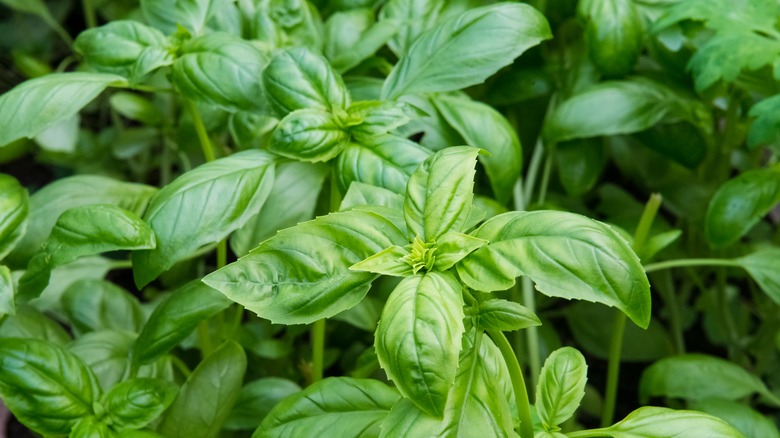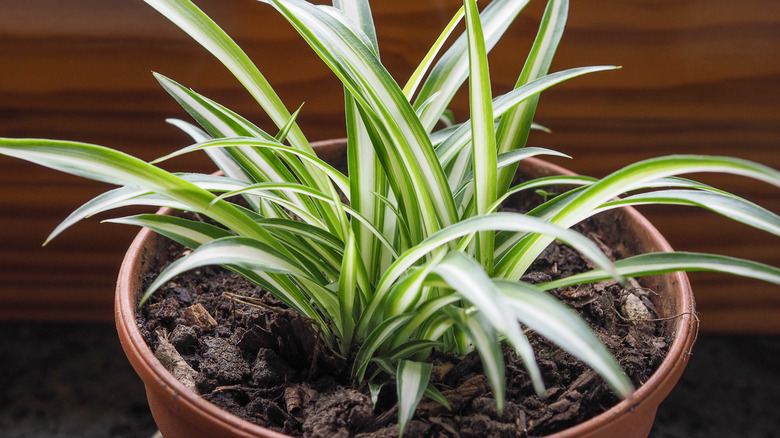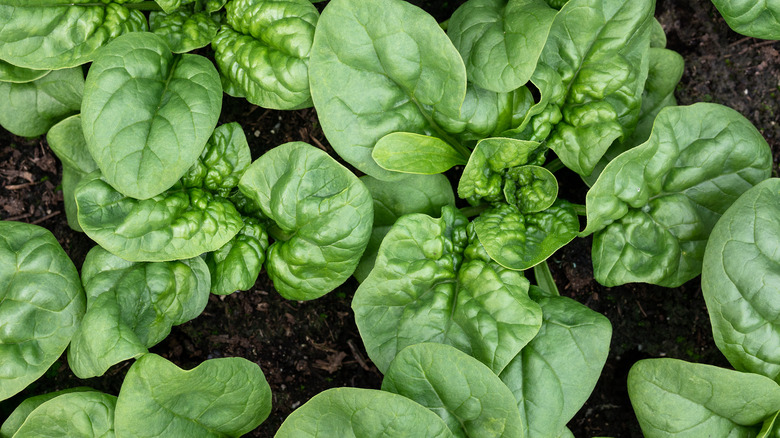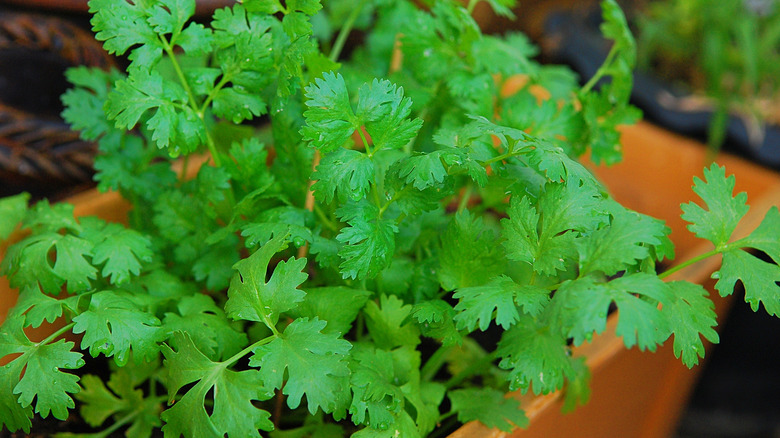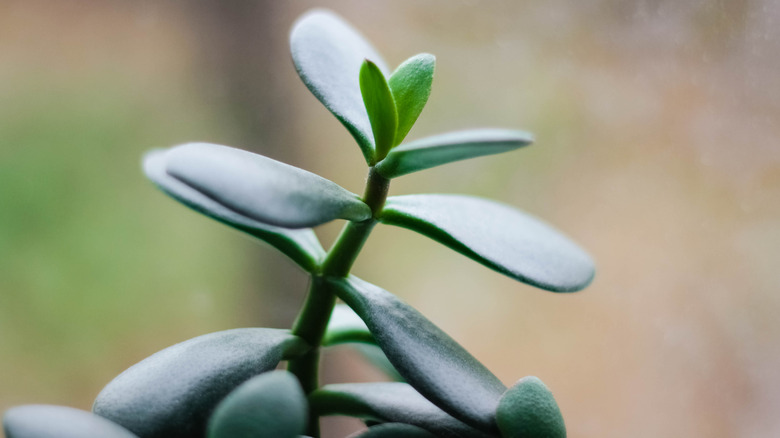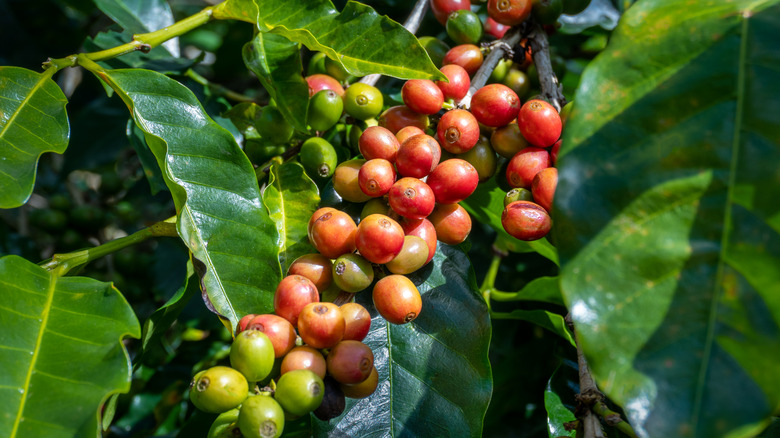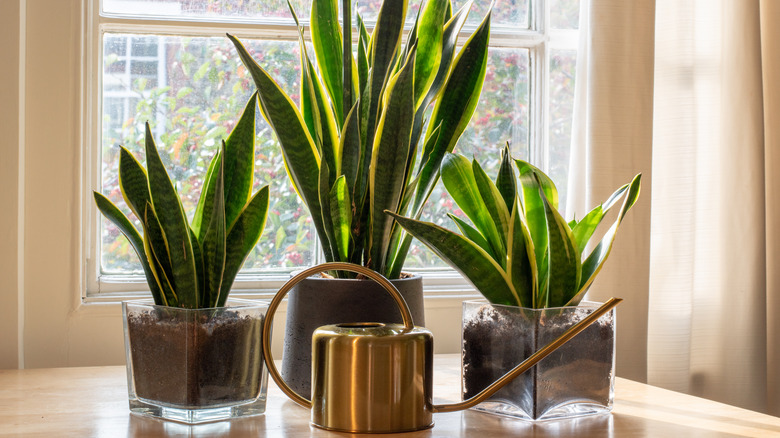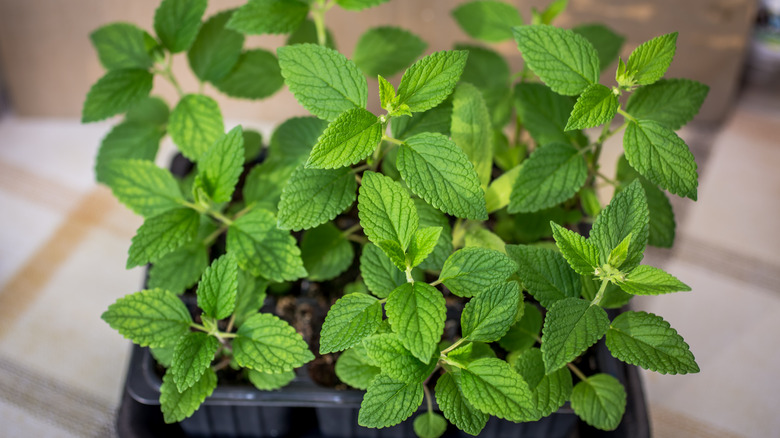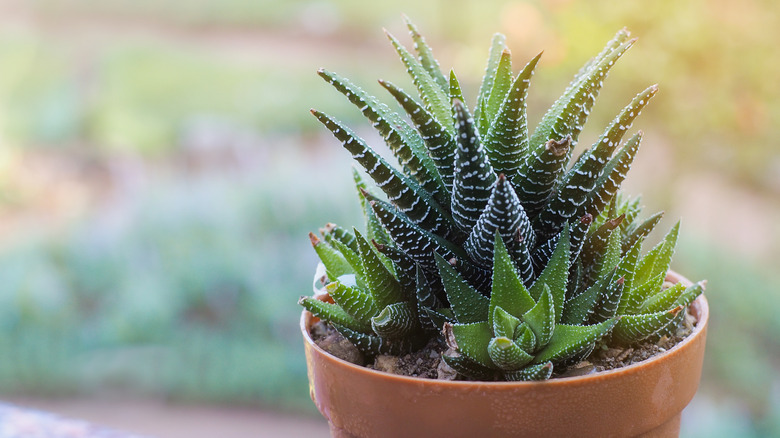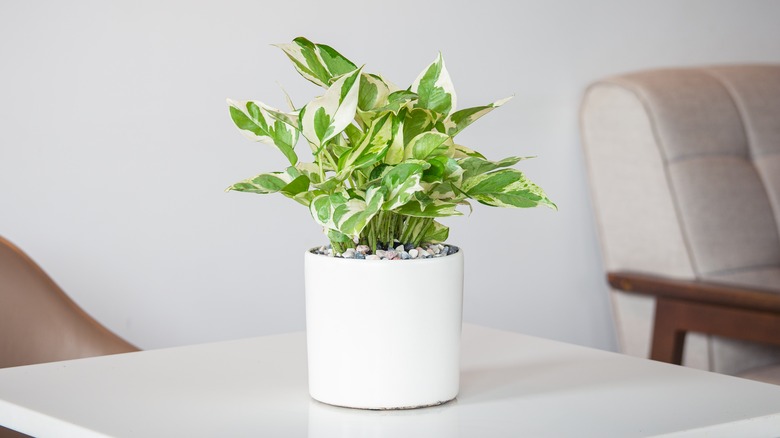25 Houseplants Perfect For Your Kitchen Window
Your kitchen is one of the best locations to grow houseplants; since it's a high-traffic area, you'll be less likely to forget to water them. Plants are a great way to bring new functionality and personality to your kitchen and the rest of your home. You can use them to decorate your kitchen with something more than basic wooden signs and ceramic jars. The right succulent, herb, or ornamental plant can serve you in many ways such as purifying the air, lifting the energy in a space, or adding some flavor to your next meal — and you'll be able to harvest fresh herbs indoors right from your counter or sunny window sill.
If you're struggling to find the best options, we've got you covered. In this collection of houseplants, we've compiled 25 different plants that bring something new to the kitchen. Each of these has its own wonderful characteristics that will complement your home nicely. Before you choose your plants, however, be sure to check which direction your kitchen window is facing. The light your kitchen has to offer is one of the main factors you'll need to consider when picking which plants to grow, notes University of Minnesota Extension. Whether you're looking for flowering sun lovers or tropical foliage-filled plants that love humidity, we have something for you.
1. Aluminum plant
Aluminum plants (Pilea cadierei) are the perfect addition to a kitchen as they highlight any metallic accents with their own splash of silver. The foliage of the aluminum plant has many gorgeous features including serrated edges, variegations, and an evergreen habit, according to University of Florida.
Bloom Season: Rarely flowers indoors
USDA Growing Zone: 11 to 12
Growing Conditions: Bright or medium indirect light
Soil Type: Well-drained potting mix
Size: 9 to 12 inches tall and 6 to 9 inches wide
2. String of hearts
The string of hearts plant (Ceropegia woodii), which is known for its heart-shaped leaves, can add more love to your kitchen window sill. This plant looks its best in a hanging planter where its foliage can hang from an elevated position. University of Wisconsin-Madison warns that the string of hearts plant can lose its dark coloring when it's exposed to too much sunlight.
Bloom Season: Summer to fall
USDA Growing Zone: 10 to 11
Growing Conditions: Bright indirect light
Soil Type: Well-draining potting mix
Size: Up to 3 feet long
3. Mint
Mint plants (Mentha spp.) just make sense in the kitchen. When you're in the mood for some mint tea or a mint julep, you can harvest a few leaves from your countertop herb garden and make your favorite drinks with fresh ingredients. To properly grow a mint plant, be sure to provide it with consistently moist yet well-draining soil and plenty of sunlight, explains Utah State University.
Bloom Season: Summer to fall
USDA Growing Zone: 3 to 8
Growing Conditions: Bright indirect light
Soil Type: Moist, rich, and well-draining potting mix
Size: Up to 2 feet tall
4. Peace lily
Peace lilies (Spathiphyllum spp.) are among the most common houseplants because they can thrive in low lit corners. These beautiful and classic flowers are easy to grow indoors and they are a delightful sight during the spring when they bloom with fragrant white flowers, mentions Clemson Cooperative Extension.
Bloom Season: Spring
USDA Growing Zone: 10 to 11
Growing Conditions: Bright to medium indirect light
Soil Type: Well-draining potting mix
Size: 1 to 6 feet tall
5. Chives
Chives (Allium schoenoprasum) are good herbs to grow in your kitchen, especially if you're looking for something that is both functional and pretty. Chives can act as ornamental and grassy houseplants or they can function as kitchen ingredients to be added on top of baked potatoes and nachos. The Royal Horticultural Society explains that this bulbous perennial is easy to grow, but it does need fertile and well-draining soil.
Bloom Season: Summer
USDA Growing Zone: 4 to 8
Growing Conditions: Bright indirect light
Soil Type: Evenly moist, fertile, and well-draining potting mix
Size: 4 to 20 inches tall and 4 inches wide
6. Peacock plant
The peacock plant (Calathea makoyana) is known for its gorgeous striped foliage. This warm-weather plant needs lots of consistent humidity and warm temperatures, however, it does not need much sunlight, advises Missouri Botanical Garden. The best place to grow your peacock plant may be near your kitchen sink or in another humid area of your home.
Bloom Season: Does not bloom indoors
USDA Growing Zone: 11 to 12
Growing Conditions: Medium to low indirect light
Soil Type: Well-draining and humus-rich potting mix
Size: 1 to 2 feet tall and 9 to 12 inches wide
7. Oregano
Oregano (Origanum vulgare) is an herbaceous plant that can be used fresh or dried. This easy-to-grow houseplant has delicious and fragrant foliage that grows quite thick, especially as the plant ages. Like other kitchen herbs, this one needs plenty of sunlight and water as well as soil that drains well, says Washington State University.
Bloom Season: Summer
USDA Growing Zone: 3 to 9
Growing Conditions: Bright indirect light
Soil Type: Well-draining potting mix
Size: 2 feet tall and wide
8. Gold tooth aloe
Gold tooth aloe (Aloe nobilis) is a fun species of aloe that features red-orange coloring on the tips of its thick leaves. Most often, this succulent will only grow to become about 12 inches tall, especially when it's kept indoors, per Mountain Crest Gardens. If your kitchen window sill isn't very wide, the aloe plant can be kept small with the right size container.
Bloom Season: Summer
USDA Growing Zone: 9 to 11
Growing Conditions: Bright direct light
Soil Type: Well-draining potting mix
Size: 9 to 18 inches tall
9. Peperomia
The peperomia (Peperomia caperata) is an evergreen houseplant with rippled leaves that can be purple, red, green, or variegated. The Royal Horticultural Society makes it clear that this plant should only be grown in well-draining soil in a sunny window. Throughout the spring and summer, peperomia can be fertilized to encourage a bushier habit and profuse flowering.
Bloom Season: Summer
USDA Growing Zone: 11 to 12
Growing Conditions: Bright to medium indirect light
Soil Type: Well-draining potting mix
Size: 6 to 8 inches tall and 6 to 24 inches wide
10. Venus fly trap
The Venus fly trap (Dionaea muscipula), which is native to North and South Carolina, is a well-known carnivorous plant featuring mouth-like leaves that attract insects with nectar. As a houseplant, these can be tricky to maintain; Venus fly traps require moist bog soil, high humidity, and specific temperatures throughout the year, explains Missouri Botanical Garden, but they're sure to take care of any pesky houseflies!
Bloom Season: Spring
USDA Growing Zone: 5 to 8
Growing Conditions: Bright indirect light
Soil Type: Moist potting mix
Size: 6 to 12 inches tall and 6 to 9 inches wide
11. Air plant
Air plants (Tillandsia spp.) are among the easiest plants to grow indoors. They are true low maintenance plants that require nothing except some infrequent watering and a sunny location. According to Penn State Extension, air plants can be used around the home as natural decoration in many ways. Tuck yours into bare corners for a pop of color or create a beautiful centerpiece with other elements.
Bloom Season: Only blooms once in a lifetime
USDA Growing Zone: 10 to 11
Growing Conditions: Bright indirect sunlight
Soil Type: Does not grow in soil
Size: 2 to 12 inches tall
12. Thyme
Thyme (Thymus vulgaris) is a member of the mint family, though its taste is much different than peppermint and spearmint. North Carolina State Extension describes the herb as a woody evergreen perennial that features very fragrant leaves. It should be harvested in the spring just before it flowers. Afterward, it may be used fresh or dried for later.
Bloom Season: Spring and summer
USDA Growing Zone: 5 to 9
Growing Conditions: Bright indirect light
Soil Type: Evenly moist and well-draining potting mix
Size: 6 to 12 inches tall and wide
13. Heartleaf philodendron
The heartleaf philodendron (Philodendron hederaceum) is the perfect houseplant to add to a kitchen begging for a bit more greenery. It only needs a bright window sill and a well-draining potting mix. This philodendron species is known for its beautiful growth habit that allows it to creep along walls and posts, points out Missouri Botanical Garden, which makes it an excellent décor piece.
Bloom Season: Rarely flowers indoors
USDA Growing Zone: 11 to 12
Growing Conditions: Bright indirect light
Soil Type: Well-draining potting mix
Size: 10 to 20 feet long
14. Parsley
Parsley (Petroselinum crispum) is an herb from the carrot family that is a bit more challenging to grow indoors than other herbs. University of Wisconsin-Madison lets us know that this herb should be grown in richer soil with plenty of access to bright light. You can choose between curly and broad-leaf varieties, or try your hand at growing them both.
Bloom Season: Summer
USDA Growing Zone: 3 to 9
Growing Conditions: Bright indirect light
Soil Type: Rich and well-draining potting mix
Size: 12 to 18 inches tall
15. African violet
African violets (Saintpaulia ionantha) are loved for their colorful foliage and long-blooming flowers. These flowers always have five petals and a star-like shape, but they may be white, purple, pink, red, yellow, or bicolor. University of Vermont says that African violets grow well indoors under artificial light or in north facing windows.
Bloom Season: Flowers freely
USDA Growing Zone: 11 to 12
Growing Conditions: Indirect medium to low light
Soil Type: Loose, highly organic potting medium
Size: 6 to 9 inches tall
16. Basil
The basil plant (Ocimum basilicum) has many uses. Not only does it grow to become a very attractive house plant, but it also provides delicious leaves that can be used in a variety of dishes. This herb has a few different cultivars, some meant for ornamental use and others for cooking. According to Missouri Botanical Garden, among the most popular varieties are 'Boxwood', 'Nufar', and 'Sweet Large Leaf Italian.'
Bloom Season: Summer to fall
USDA Growing Zone: 2 to 11
Growing Conditions: Bright indirect light
Soil Type: Rich and well-draining potting mix
Size: Up to 2 feet tall and wide
17. Spider plant
The spider plant (Chlorophytum comosum) has been grown inside the home to create natural interest for many decades. San Marcos Growers describes the plant as a South African evergreen perennial that features slender and arching foliage. The appearance of the foliage is what named the plant; when grown in a container the leaves produce offsets that look like hanging spiders.
Bloom Season: Spring and summer
USDA Growing Zone: 9 to 11
Growing Conditions: Medium to bright light
Soil Type: General purpose potting mix
Size: 1 to 2 feet tall and wide
18. Spinach
Spinach plants (Spinacia oleracea) are not frequently grown indoors, but that doesn't mean it's impossible to do so. In fact, in the kitchen, one or more spinach houseplants can come in handy. Spinach is packed with essential nutrients that we would do well to consume daily, including vitamins A and C, folic acid, and iron, notes Healthline.
Bloom Season: Summer
USDA Growing Zone: 1 to 11
Growing Conditions: Bright indirect light
Soil Type: Well-draining potting mix
Size: 6 to 12 inches tall and wide
19. Cilantro
No kitchen should be without fresh cilantro (Coriandrum sativum). This herb is a versatile and delicious addition to many meals. North Carolina State Extension reminds us that all parts of the plant are edible including the flowers, seeds, and stems. From tacos to soups, cilantro can add flavor that can't be beaten. Unless, of course, you have the olfactory receptor gene that makes it taste like soap.
Bloom Season: Summer
USDA Growing Zone: 2 to 11
Growing Conditions: Bright indirect light
Soil Type: Well-draining potting mix
Size: 1 to 2 feet tall and wide
20. Jade
If you're looking for a plant for your kitchen counter that you won't have to watch closely, the jade plant (Crassula argentea) is for you. University of Florida reports that this succulent should be grown away from direct sunlight and in acidic, well-draining soil. With minimal care, your jade plant will grow thick green leaves and small white flowers.
Bloom Season: Spring
USDA Growing Zone: 10 to 11
Growing Conditions: Medium or low indirect light
Soil Type: Well-draining potting mix
Size: 2 to 4 feet tall and 1 to 3 feet wide
21. Coffee plant
The coffee plant (Coffea arabica) does actually produce coffee beans, according to Logee's. However, you're unlikely to replace your store-bought beans with a single plant. Still, the coffee plant is fun to grow and it rewards you with fragrant foliage, red berries, and white flowers over its growing season. Just give it a bright spot by the window.
Bloom Season: Spring and summer
USDA Growing Zone: 10 to 12
Growing Conditions: Bright direct light
Soil Type: Rich, well-draining potting mix
Size: 3 to 5 feet tall
22. Snake plant
Snake plants (Dracaena trifasciata) can be grown just about anywhere in your home. In your kitchen window, your fast growing snake plant can be kept manageable in a small container. Unlike other finicky plants, the snake plant can survive being root bound for some time, although Penn State Extension warns that they may eventually break out of their container. Be careful to watch for any cracking.
Bloom Season: Spring
USDA Growing Zone: 9 to 11
Growing Conditions: Medium to low indirect light
Soil Type: Well-drained potting mix
Size: 6 inches to 3 feet tall depending on the variety
23. Catnip
Catnip plants (Nepeta cataria) aren't just for cats. They can be used in the kitchen to make tea or they can be grown for strict ornamental use. The Royal Horticultural Society advises gardeners to keep their catnip plants in full sunlight for the best growth. They also need well-draining soil and plenty of water. If your catnip plant is growing too large, prune it after it flowers to control its habit.
Bloom Season: Summer and fall
USDA Growing Zone: 3 to 7
Growing Conditions: Bright indirect light
Soil Type: Well-draining potting mix
Size: 2 to 3 feet tall and wide
24. Haworthia
There are many different haworthia species (Haworthia spp.), and each of them has very similar needs. You can grow just one in your kitchen or you can expand your collection to include several types all grown in the same container. University of Wisconsin-Madison encourages gardeners to plant an assortment of these succulents to enjoy on their window sill.
Bloom Season: Summer
USDA Growing Zone: 10 to 11
Growing Conditions: Bright direct or indirect light
Soil Type: Well-draining potting mix
Size: 6 to 8 inches tall and 4 to 6 inches wide
25. Golden pothos
Pothos plants (Epipremnum aureum), which go by many different names including devil's ivy, devil's vine, and ivy arum, are a species of vining evergreen plants that have found their way into the homes and hearts of gardeners around the world. North Carolina State Extension recommends planting this vine in a hanging basket where its gorgeous leaves can trail around your kitchen as a natural decoration.
Bloom Season: Does not flower
USDA Growing Zone: 10 to 12
Growing Conditions: Bright, medium, or low indirect light
Soil Type: Well-draining potting mix
Size: Up to 40 feet long
